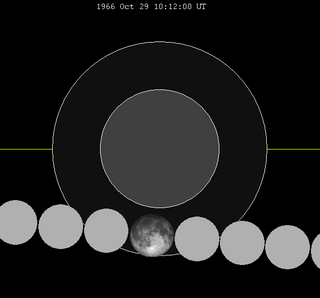Loading AI tools
Penumbral lunar eclipse October 29, 1966 From Wikipedia, the free encyclopedia
A penumbral lunar eclipse took place on Saturday, October 29, 1966, the second of two lunar eclipses in 1966. This was a deep penumbral eclipse, with over 90% within Penumbral Shadow.[1]

| Lunar eclipse series sets from 1966–1969 | ||||||||
|---|---|---|---|---|---|---|---|---|
| Descending node | Ascending node | |||||||
| Saros | Date Viewing |
Type Chart |
Gamma | Saros | Date Viewing |
Type Chart |
Gamma | |
| 111 | 1966 May 4 |
Penumbral |
1.05536 | 116 | 1966 Oct 29 |
Penumbral |
−1.05999 | |
| 121 | 1967 Apr 24 |
Total |
0.29722 | 126 | 1967 Oct 18 |
Total |
−0.36529 | |
| 131 | 1968 Apr 13 |
Total |
−0.41732 | 136 | 1968 Oct 6 |
Total |
0.36054 | |
| 141 | 1969 Apr 2 |
Penumbral |
−1.17648 | 146 | 1969 Sep 25 |
Penumbral |
1.06558 | |
| Last set | 1965 Jun 14 | Last set | 1965 Dec 8 | |||||
| Next set | 1970 Feb 21 | Next set | 1969 Aug 27 | |||||
The metonic cycle repeats nearly exactly every 19 years and represents a Saros cycle plus one lunar year. Because it occurs on the same calendar date, the Earth's shadow will in nearly the same location relative to the background stars.
| Metonic events: May 4 and October 28 | |
|---|---|
| Descending node | Ascending node |
|
|
 |
 |
A lunar eclipse will be preceded and followed by solar eclipses by 9 years and 5.5 days (a half saros).[2] This lunar eclipse is related to two solar eclipses of Solar Saros 123.
Seamless Wikipedia browsing. On steroids.
Every time you click a link to Wikipedia, Wiktionary or Wikiquote in your browser's search results, it will show the modern Wikiwand interface.
Wikiwand extension is a five stars, simple, with minimum permission required to keep your browsing private, safe and transparent.